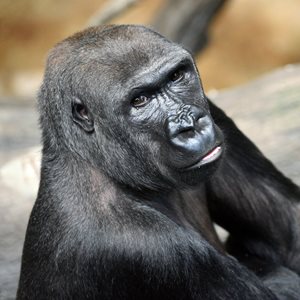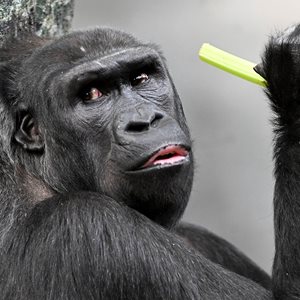Animal welfare scientists spend much of their time observing any of the over 500 species here at Brookfield Zoo. Using specialized software to record animal behavior, researchers can learn much about how an animal interacts with its environment and monitor their welfare. This information can help animal care staff constantly improve the care they provide. For example, information from behavioral observations can be used to help understand which areas of the habitat an animal uses and its unique preferences. Each animal can have different experiences with and display different responses to the same environment due to a variety of factors such as age, health status, social ranking, and personality. Therefore, it is important to record behavioral observations for every animal in the social group. Good animal welfare starts with the individual!
But how do researchers tell individual animals apart? That depends on the animals you are observing! For animals that are hard to recognize based on looks alone, animal care staff give animals a physical identifier. For example, birds wear rings on their legs, and each individual’s ring has a different color or code. The penguins are slightly different, and wear their rings around their flipper-like wings as bracelets.
For other species, researchers simply need to spend some time with their subjects to learn how to tell them apart. Just like how we learn to tell other humans apart based on features such as someone’s hair color or height, many animals have features that set them apart from their conspecifics. For example, animals with stripes and spots (e.g. tiger, okapi, clouded leopard) are born with a pattern that is completely unique.
As the zoo’s Behavioral Research Assistant, I have been putting my identification skills to good use lately while monitoring the behavior of our western lowland gorilla troop. Currently, the gorilla family includes three adult females (Binti, Koola, and Kamba), two juvenile females (Nora and Ali), and one adult male (Jontu). The easiest way to learn the differences between individual animals is to start with the obvious differences first. One of the most obvious is size. For example, Jontu weighs around twice as much as the adult females in our gorilla troop! Ignoring this huge difference, we can also identify Jontu by the patch of pale silver fur on his back which makes him an adult male (also known as a silverback gorilla). As a less dramatic example, juvenile gorillas Nora and Ali are smaller than the adult females, with younger sister Ali significantly smaller than Nora (for now!). The adult females are harder to tell apart by obvious differences, but our oldest female Binti has the palest and thinnest fur.
Sometimes, the animals being studied do not have obvious differences in size or coloring. What do researchers do then? We use more subtle differences, such as the facial features we use to identify other humans. In big cats, each animal has a unique pattern in their whiskers, and elephants have unique ear shapes. Using our gorilla troop as our example, researchers both in the wild and in zoos take advantage of one specific facial feature--their nose! Each gorilla’s nose has a unique pattern of wrinkles and ridges, termed “nose prints”. In our troop, Koola and her oldest daughter Kamba are a similar size and fur color, and it can be hard to tell them apart if you are not familiar with them. However, they have dramatically different nose prints, with Koola (below right) having a relatively flat nose with one deep wrinkle down the middle and Kamba (below left) having several deeper wrinkles above her nose. Other subtle differences such as head shape are useful as well (Kamba’s head is rounder than Koola’s and Nora has a more oval shaped head than Ali).


While this sounds like a lot of information to keep in mind while collecting behavioral data, identifying individual animals becomes easier the more you practice! After enough time, it becomes second nature. Just like when we make friends with our fellow humans, we no longer think about the individual features and instead can focus on the animal as a whole. The next time you find yourself in Tropic World, see if you can use your skills as a scientist to tell our gorilla troop apart.
Maggie Ramont
Behavioral Research Assistant
Published January 11, 2024